 Sámegillii
Sámegillii  På norsk
På norskArticles about Sami school history
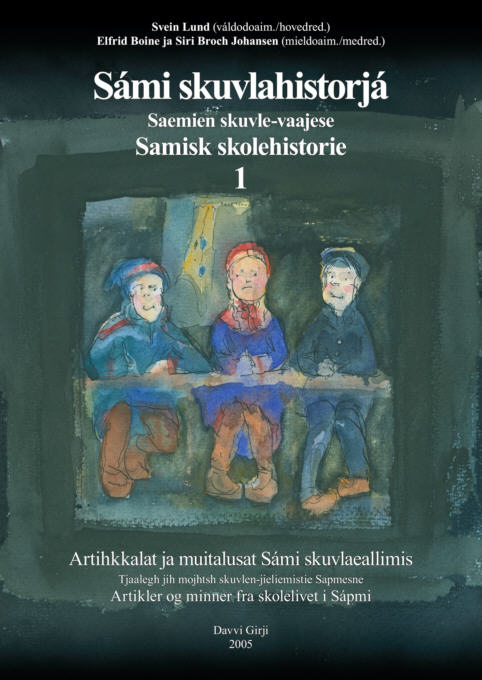 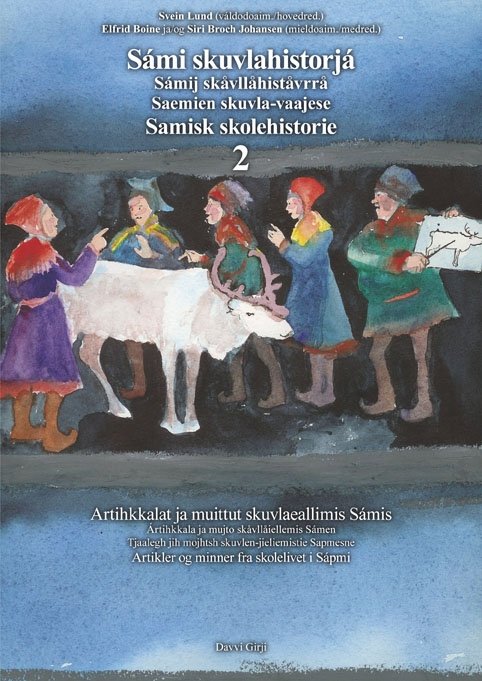 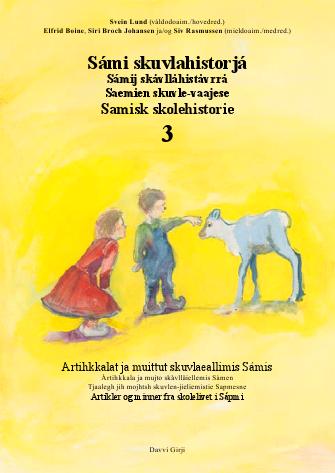 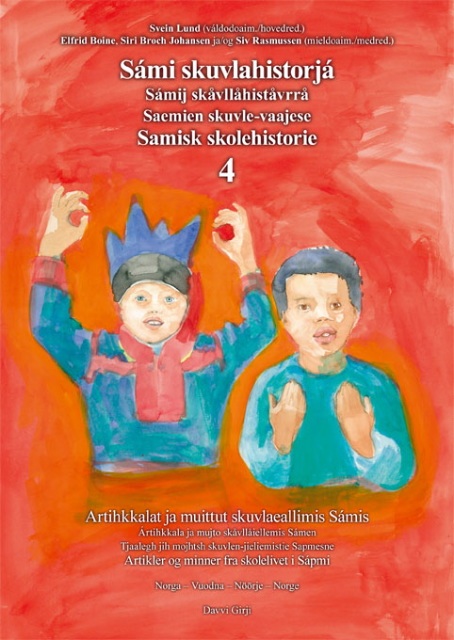 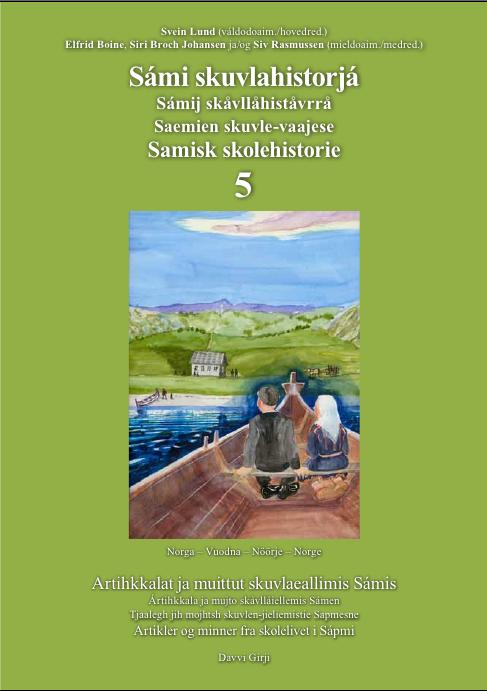
Do you know Sami school history?Sámi skuvlahistorjá / Samisk skolehistorie (Sami School History) is a series of books published by the publishing house Davvi Girji. In about 200 articles in 5 volumes there is told about the experiences of Sami children in Norwegian schools, and about the changes in the educational politics of the Norwegian authorities towards the Sami population. The books are published with parallell text in Sami and Norwegian language.In this web site some of the articles of the first book are also published in English. It would be too much to translate it all, so to make this history available to a greater public, we are translating a series of newspaper articles, which sorted by topics make a summary of stories in the books. So far there are 28 articles published in Sami language by the Sami newspapers Min Áigi and Ávvir. They are also published here in Norwegian and the English version will be published gradually as they are translated. These articles are edited by the main editor, Svein Lund. Besides him the editing board of the book series consist of Elfrid Boine, Siri Broch Johansen and Siv Rasmussen. |
Here we have edited out some parts of documents telling this story. The whole documents can be read (in Norwegian or Sami language) in the book Samisk skolehistorie 2.
Up until this day we have in fact just one school that is Sami and that at the same time can give some sort of higher education. I’m referring to The Sami folk high school in Karasjok. What this has meant for the people can’t easily be measured. But the love and sympathy given from Finnmark in the north to Femunden in the south may give a small indication. What is then the reason for its success? Yes, it is the Sami peoples’ own school, the only one. Here they can be themselves. Here they don’t need to be afraid of being looked down upon and despised. Here it’s equally good to be Sami as it is to be Norwegian. And no less important, here they get education in their own language, and acquire knowledge of their ancestral heritage.
Oh no, there is no reason to doubt that the folk high school in Karasjok has fulfilled its promises. Yet at the same time it has revealed an enormous need, the need for a Sami school system throughout the whole education. Educational institutions where children and youth don’t have to experience the trampling of their parents’ language and culture, or simply see it passed in silence. Where they can be allowed to meet the new on the foundations of the old, and themselves be a part of building up the Samiland of tomorrow.
To reach that goal, we must at the very least aim for a school of higher education. The people need leaders. They need skilful men and women who fully master the Norwegian language and belong in the Western European common culture, yet who at the same time through thorough introduction in their mother tongue and heritage, have gained the necessary prerequisites to compare both cultures against each other. Only then can they find a synthesis in pact with today and the future. As it is now, the most gifted part of the youth apply for the Norwegian gymnasiums in Finnmark or further south. What this leads to is obvious: the young will most likely receive a reasonable orientation in what the schools give, being the cultural heritage of the West. But the heritage from their ancestors is pretty much outside consideration. And this happens whilst they must live and breathe daily in a Norwegian environment. Under these conditions it’s no wonder that they against their will or not are assimilated. Think about what would have happened had Norwegian youth had to go to Germany to get their artium [final secondary examination]. If we had lost the war, we would have risked doing such things. I don’t think we would have liked it.
(Stein Henriksen's article, SSH-2)
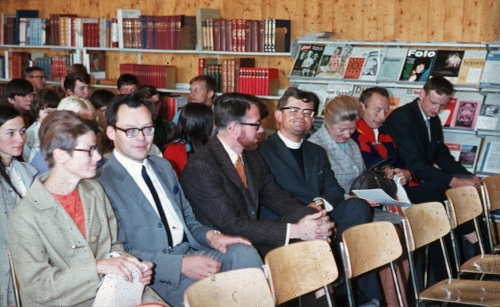 | In 1969 the gymnasium classes in Karasjok on could finally open. This is from the opening. (Photo: Per Jernsletten) |
Much has already been achieved in this matter by the State. Sami language will potentially gain a fixed legal position in primary school, and a decision will be made regarding a Sami course at the gymnasium in Alta. We are most glad and grateful for both these things. However, when we look at higher education as having a key position in the cultural reconstruction and liberation work amongst the Sami, we find that we can’t stop halfway. The people need leaders. They need men and women who feel at home just as much in the cultural treasure of the West as in their ancestral heritage, to the degree that they can manage the difficult task of considering the different forms of life against each other and create the synthesis between them both… ...
In the process of creating this elite we believe that the environment and the teaching force at the educational institution will be of crucial importance. Therefore it is not possible to look at a Sami course at a Norwegian gymnasium as anything but an emergency measure. The reasonable measure must be that the Sami get their own school, relieved from the pressure a Norwegian environment inevitably must create. There they can work under the forms and breathe in the air according to their own being and quality of character, and where at the very least the teachers themselves are Sami with the same background and experience as the youth they are supposed to supervise… ...
In light of this we turn to the Finnemisjonen (Sami Mission), hoping that there are capabilities to erect a school of higher education for Sami corresponding to the principles set above.
(Sami gymnasium, SSH-2)
The question which is most discussed these days is the necessity for a Sami gymnasium. Personally I believe that such a gymnasium should be created. What we need are more people with education for the Sami. So far most doctors and teachers have only spoken Norwegian. Many of them have often not understood the Sami and their problems because of the language. It is people with Sami background who are the right ones to help the people of inner Finnmark in solving their problems.
As the conditions in the gymnasium are today, Sami youth experience problems with the Norwegian language in particular. In this field they will lose much compared to their fellow pupils. The biggest problem is not being unable to speak, but being unable to write Norwegian. We all know the difficulties of writing Norwegian is in its placement and use of prepositions. I think the linguistic difficulties are one of the main reasons why there are so few youths from inner Finnmark in gymnasiums.
For the sake of language it is in my opinion important with a Sami gymnasium where the Sami language, culture and history are emphasised. I’m sure that it would lead to more and more Sami finding their way to the gymnasium. In order to speak another language, I think it is important to know one’s own mother tongue, both the spoken and written forms. The mother tongue lies closest to heart and one has spoken it since one was little. It would in my opinion be much easier for us to learn Norwegian, had we first received the foundation of Sami language.
((Sami gymnasium, SSH-2)
From reports in the radio and the press we have gotten the impression that the Ministry of Church and Education considers the placement of a Sami gymnasium in Alta. If this report is correct, we would like to pronounce our strongest disagreement.
On the basis of our knowledge of questions regarding Sami schools, acquired through special education and in part through several years of involvement in these matters, we would strongly advise against the planned situation of a gymnasium with a Sami course in Alta. If the main purpose for a gymnasium for Sami youth should be attained, it should in our opinion be situated in a Sami environment where the Sami are a majority and characterise the life within the community. We doubt that Sami youths will apply for the Sami course at the gymnasium in Alta, and we assume that it will be hard to find teachers of Sami subjects to Alta.
We, having had special education in Sami language and cultural knowledge, do not intend to apply for teaching positions in Alta. We support the demand from the Sami organisations about stationing a gymnasium with a Sami course in Karasjok.
Signed by 28 names. At the time there were 29 people in Norway who had a formal education in Sami language.
(Sami gymnasium, SSH-2)
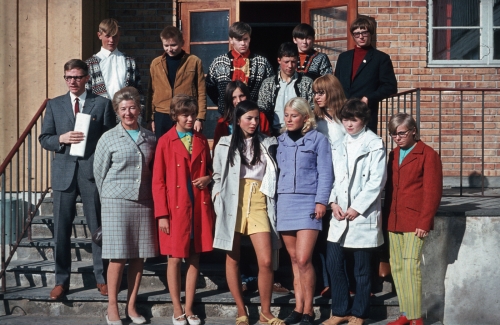 | The first classes who began at the gymnasium in Karasjok in 1969. The linguistic courses had a majority of girls, whilst the majority in the science courses was boys. (Photo: Per Jernsletten) | 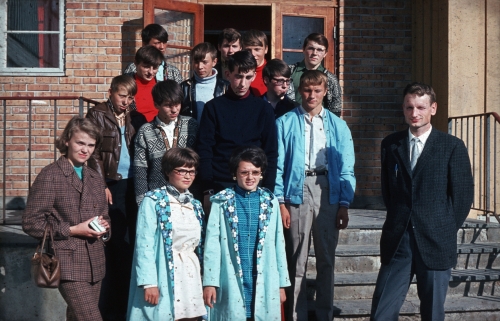 |
Here you find all the articles in the series:
28.09.2007 Why Sami school history?
05.10.2007 Boundless ignorance
12.10.2007 Southerner-teachers encounter the Sami language
19.10.2007 The start of Sami beginner instruction
26.10.2007 The start of education in reindeer-herding
02.11.2007 From Sami to Norwegian vocational training
16.11.2007 Struggle for Sami gymnasium
28.11.2007 School experiences of Norwegian speaking Samis
14.12.2007 Resistence against Sami language and culture
25.01.2008 A strange world
23.05.2009 On Sami teachers
30.05.2009 Life in boarding school
06.06.2009 Sami pupils were bullied
13.06.2009 Sami content in the teaching
20.06.2009 Pupil as interpreter
04.07.2009 How the children quit speaking Sami
10.09.2010 God does not understand Sami
08.10.2010 The point of view of the Norwegianizers
13.10.2010 Men of the church defending the Sami language
02.12.2010 Sami teachers in old times
09.12.2010 Boarding school life in old times
18.12.2010 Sami pupils in special schools
14.01.2012 The parents' struggle for Sami education
21.01.2012 Reluctance and absence
28.01.2012 The school during the war
04.02.2012 Reconstruction and barrack schools
11.02.2012 Curriculums - for Norwegianization and for Sami school
18.02.2012 The great struggle of the curriculum
Sami school history 1
Sami school history 2
Sami school history 3
Sami school history 4
Sami school history 5
Sami school history - main page